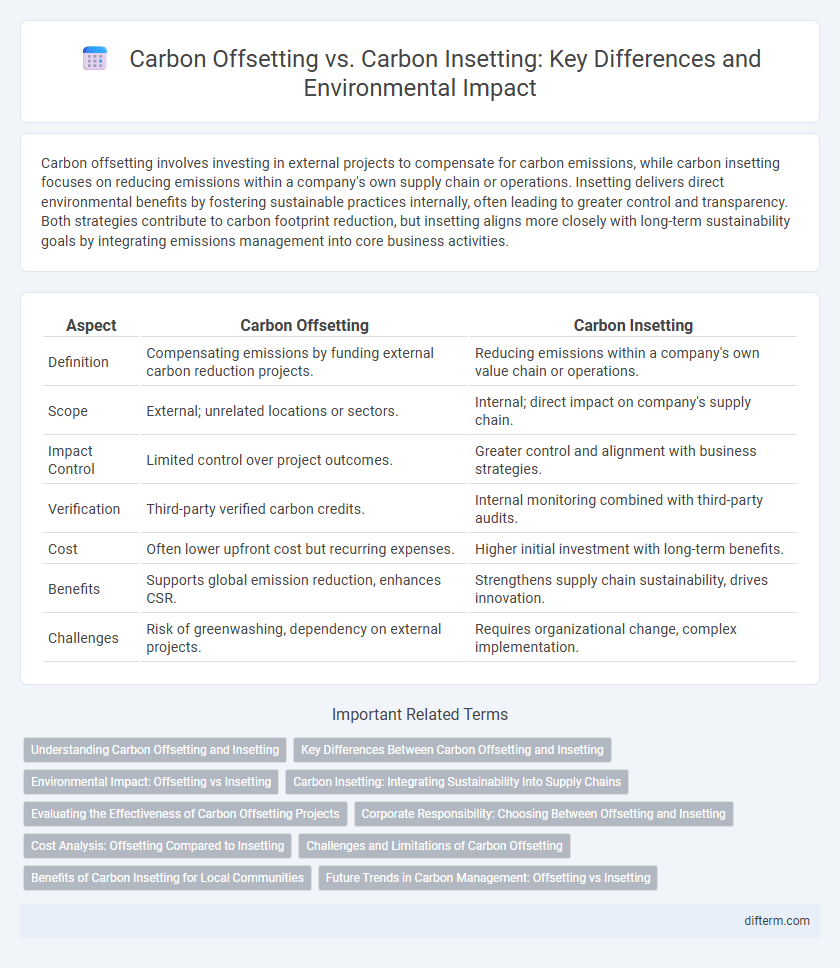Carbon offsetting involves investing in external projects to compensate for carbon emissions, while carbon insetting focuses on reducing emissions within a company's own supply chain or operations. Insetting delivers direct environmental benefits by fostering sustainable practices internally, often leading to greater control and transparency. Both strategies contribute to carbon footprint reduction, but insetting aligns more closely with long-term sustainability goals by integrating emissions management into core business activities.
Table of Comparison
| Aspect | Carbon Offsetting | Carbon Insetting |
|---|---|---|
| Definition | Compensating emissions by funding external carbon reduction projects. | Reducing emissions within a company's own value chain or operations. |
| Scope | External; unrelated locations or sectors. | Internal; direct impact on company's supply chain. |
| Impact Control | Limited control over project outcomes. | Greater control and alignment with business strategies. |
| Verification | Third-party verified carbon credits. | Internal monitoring combined with third-party audits. |
| Cost | Often lower upfront cost but recurring expenses. | Higher initial investment with long-term benefits. |
| Benefits | Supports global emission reduction, enhances CSR. | Strengthens supply chain sustainability, drives innovation. |
| Challenges | Risk of greenwashing, dependency on external projects. | Requires organizational change, complex implementation. |
Understanding Carbon Offsetting and Insetting
Carbon offsetting involves compensating for emissions by funding projects that reduce or capture greenhouse gases outside a company's direct operations, such as renewable energy installations or reforestation initiatives globally. Carbon insetting focuses on reducing emissions within a company's supply chain or operational boundaries, promoting sustainable practices like agroforestry or energy efficiency improvements locally. Both strategies aim to achieve net-zero emissions but differ in scope and geographic relevance, influencing corporate sustainability and climate impact assessments.
Key Differences Between Carbon Offsetting and Insetting
Carbon offsetting involves purchasing external credits to compensate for greenhouse gas emissions, while carbon insetting focuses on reducing emissions within a company's own value chain through sustainable projects. Offsetting typically funds projects like reforestation or renewable energy outside the organization, whereas insetting integrates environmental initiatives directly into business operations. Key differences include control over impact, with insetting offering greater alignment with corporate sustainability goals and more direct influence on emission reductions.
Environmental Impact: Offsetting vs Insetting
Carbon offsetting involves compensating for emissions by investing in external projects like reforestation or renewable energy, which can effectively reduce overall greenhouse gases but may face challenges with permanence and additionality. Carbon insetting integrates emission reduction strategies directly within a company's own value chain, promoting sustainable practices and enhancing local ecosystems, thereby delivering measurable environmental benefits and strengthening supply chain resilience. Both approaches contribute to climate mitigation, yet insetting often yields more direct and verifiable impacts on biodiversity, carbon sequestration, and community development.
Carbon Insetting: Integrating Sustainability Into Supply Chains
Carbon insetting integrates sustainability directly into supply chains by investing in emission reduction projects within a company's own operations and supplier network, enhancing accountability and traceability. Unlike carbon offsetting, which supports external projects to compensate for emissions, insetting drives internal innovation and collaboration to reduce overall carbon footprints. This approach strengthens supply chain resilience, supports local communities, and aligns with corporate sustainability goals by embedding environmental responsibility into core business practices.
Evaluating the Effectiveness of Carbon Offsetting Projects
Evaluating the effectiveness of carbon offsetting projects requires rigorous measurement of actual greenhouse gas reductions compared to their claimed impact, ensuring credibility through third-party verification standards like the Verified Carbon Standard (VCS) or Gold Standard. Carbon offsetting projects often face criticism for issues such as carbon leakage, permanence, and additionality, which can undermine their environmental benefits. In contrast, carbon insetting, focused on reducing emissions within a company's own supply chain, tends to provide more direct and measurable sustainability outcomes.
Corporate Responsibility: Choosing Between Offsetting and Insetting
Corporate responsibility in environmental sustainability increasingly involves selecting between carbon offsetting and carbon insetting to reduce a company's carbon footprint. Carbon offsetting allows businesses to invest in external projects like reforestation or renewable energy to compensate for emissions, while carbon insetting focuses on internal efforts within the company's supply chain, promoting sustainable practices and operational improvements. Prioritizing insetting fosters deeper supply chain accountability and long-term emission reductions, aligning closer with corporate sustainability goals and stakeholder expectations.
Cost Analysis: Offsetting Compared to Insetting
Carbon offsetting often involves purchasing external credits to compensate for emissions, which can entail ongoing costs and reliance on third-party projects. Carbon insetting, by investing directly in internal or local sustainability initiatives, may demand higher initial capital but offers long-term financial benefits through operational efficiencies and community engagement. Analyzing cost effectiveness requires considering project scale, duration, verification expenses, and potential returns on investment within an organization's supply chain.
Challenges and Limitations of Carbon Offsetting
Carbon offsetting faces challenges such as the risk of double counting, where the same emissions reductions are claimed by multiple parties, reducing its effectiveness. Verification and monitoring difficulties lead to uncertainties regarding the actual impact and permanence of offset projects. Furthermore, carbon offsetting may inadvertently delay urgent emissions reductions by allowing companies to rely on offsets rather than implementing internal sustainability measures.
Benefits of Carbon Insetting for Local Communities
Carbon insetting directly benefits local communities by funding sustainable projects within their own regions, enhancing environmental quality and promoting economic development. This approach supports biodiversity conservation and renewable energy initiatives, creating local jobs and improving public health. By investing in nearby ecosystems, carbon insetting fosters stronger community resilience and long-term climate action.
Future Trends in Carbon Management: Offsetting vs Insetting
Future trends in carbon management emphasize a shift from traditional carbon offsetting towards carbon insetting, driven by the need for more localized and transparent climate actions. Carbon insetting integrates emissions reduction projects within a company's own supply chain, fostering direct environmental and social benefits. Advances in blockchain and satellite monitoring technologies enhance the accuracy, traceability, and reporting of both offsetting and insetting initiatives, facilitating more reliable carbon accounting.
carbon offsetting vs carbon insetting Infographic

 difterm.com
difterm.com